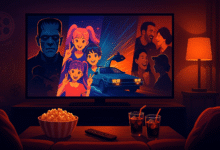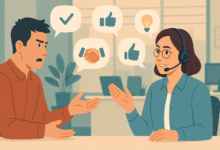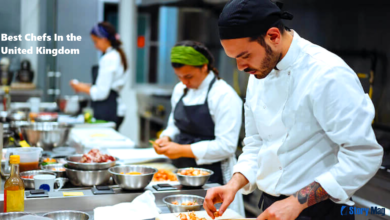The Profound Impact of Social Media on UK Art & Culture Trends

Over the past two decades, social media has fundamentally altered how art is created, shared, and consumed in the United Kingdom. Platforms like Instagram, TikTok, X (formerly Twitter), and Facebook have dismantled traditional gatekeeping structures, allowing artists to reach global audiences without institutional backing. The impact of social media on UK art extends beyond mere exposure—it has reshaped artistic movements, democratized creativity, and even influenced the programming of major cultural institutions.
This in-depth exploration examines how social media has revolutionized the UK’s art and cultural landscape, analyzing its role in artist empowerment, trendsetting, institutional adaptation, and the challenges it presents.
EXPLORE THE CONTENTS
1. The Democratization of Art: Breaking Down Barriers
The Pre-Social Media Art World
Before the rise of social media, the UK art scene was largely controlled by galleries, curators, and critics. Emerging artists struggled to gain recognition without connections to established institutions. Physical exhibitions in London, Manchester, or Edinburgh were primary avenues for exposure, leaving many talented creators—particularly those from underrepresented backgrounds—without a platform.
How Social Media Changed the Game
Social media has democratized art by allowing creators to bypass traditional gatekeepers. Key developments include:
A. Direct Artist-to-Audience Engagement
- Artists no longer rely solely on gallery representation. Instagram, Behance, and DeviantArt serve as digital portfolios accessible to millions.
- Example: British illustrator Hannah Adamaszek gained a massive following through Instagram before being featured in major exhibitions.
B. Amplification of Diverse Voices
- Marginalized artists, including those from BAME (Black, Asian, and Minority Ethnic) communities, LGBTQ+ creators, and disabled artists, use social media to share their work without institutional bias.
- Movements like #BuyBlackArt and #DisabilityArt have thrived on Twitter and Instagram, fostering inclusivity.
C. New Revenue Streams
- Platforms like Patreon, Ko-fi, and Etsy allow artists to monetize their work directly.
- NFTs (Non-Fungible Tokens) gained traction through Twitter and Clubhouse discussions, with UK artists like Trevor Jones achieving record sales.
The Result: A More Inclusive Art Scene
Social media has made UK art more accessible, enabling niche styles—such as digital surrealism, hyper-realistic portraiture, and street art—to flourish outside traditional galleries.
2. Social Media as a Trendsetter in UK Art
How Viral Trends Shape Artistic Movements
Social media accelerates cultural shifts, turning underground styles into mainstream phenomena. The impact of social media on UK art is evident in how quickly trends emerge and evolve.
A. Hashtag Challenges & Artist Collaborations
- #Inktober and #DrawThisInYourStyle encourage artists to reinterpret each other’s work, fostering community.
- TikTok’s #ArtProcess videos reveal behind-the-scenes creativity, making art more relatable.
B. The Rise of Digital & NFT Art
- Beeple’s $69 million NFT sale (2021) sparked a digital art revolution in the UK.
- British artists like Damien Hirst and Banksy have experimented with NFTs, blending traditional and digital mediums.
C. Street Art Goes Viral
- Banksy’s guerrilla artworks gain instant global attention via Instagram.
- Platforms like Reddit and YouTube document UK street art, preserving ephemeral works digitally.
The Speed of Trend Cycles
Unlike traditional art movements (which took decades to develop), social media trends can dominate within weeks. This rapid cycle keeps the UK art scene dynamic but also pressures artists to constantly innovate.
3. Instagram & TikTok: The New Digital Galleries
Instagram’s Dominance in Visual Art
As the leading platform for artists, Instagram offers:
- Visual Storytelling: Carousel posts and Reels showcase artwork evolution.
- Hashtag Discovery: #UKArtist (3M+ posts) and #LondonArt help users find local talent.
- Institutional Use: The Tate, V&A, and National Gallery use Instagram to promote exhibitions.
TikTok’s Explosive Growth Among Young Artists
- #ArtTok has 4.7 billion views, featuring timelapses, tutorials, and challenges.
- The algorithm-driven “For You Page” (FYP) helps unknown artists go viral overnight.
- Example: **British painter @davidhockneyofficial (despite being 86) gained a Gen Z following through TikTok.
YouTube: Long-Form Art Content
- Channels like **Great Art Explained break down UK masterpieces for global audiences.
- Documentary-style videos on Banksy’s identity and graffiti in Shoreditch attract millions.
4. How Traditional UK Institutions Adapt to Social Media
Museums & Galleries Embrace Digital Strategies
A. Virtual Exhibitions & Online Archives
- During COVID-19, the British Museum and National Gallery offered virtual tours.
- The V&A’s “Digital Futures” program explores AR and VR in art curation.
B. Interactive Engagement
- Twitter Q&As with curators (e.g., @Tate).
- Instagram Live studio visits with artists like Tracey Emin.
C. Memes & Pop Culture Crossover
- The Tate’s “Please Respect the Art” memes went viral, attracting younger visitors.
- The National Portrait Gallery’s TikTok reenactments of historical paintings.
Challenges for Traditional Institutions
- Balancing digital & physical experiences without losing authenticity.
- Monetizing online content (e.g., paid virtual tours vs. free social media posts).
5. The Dark Side: Challenges of Social Media for UK Artists
A. Oversaturation & Algorithm Dependency
- With 95 million Instagram posts tagged #Art, standing out is difficult.
- Artists must constantly adapt to changing algorithms (e.g., Instagram’s shift from photos to Reels).
B. Copyright Theft & AI Art Controversies
- Viral art is often reposted without credit or compensation.
- AI-generated art (e.g., MidJourney) raises ethical questions about originality.
C. Mental Health & Burnout
- The pressure to post daily leads to creative fatigue.
- Comparison culture on Instagram affects artists’ self-esteem.
6. The Future: Where UK Art & Social Media Are Heading
A. Augmented Reality (AR) & Virtual Exhibitions
- Instagram filters turn users into living artworks.
- Saatchi Art’s VR gallery allows digital exhibitions.
B. AI & Blockchain Innovations
- AI-assisted art tools (like DALL-E) are changing creative workflows.
- NFT galleries in London (e.g., The NFT Gallery) blend physical and digital art.
C. Decentralized Social Platforms
- Some artists migrate to Mastodon and Cara to avoid corporate algorithms.
Conclusion: Social Media as a Cultural Catalyst
The impact of social media on UK art is undeniable—it has democratized access, accelerated trends, and forced institutions to evolve. However, challenges like oversaturation, copyright issues, and mental health pressures remain.
As technology advances, UK artists must balance digital engagement with artistic integrity. One thing is certain: social media is now an inseparable part of the UK’s cultural identity.
What’s next? Follow emerging UK artists online, support digital art movements, and engage in the conversation shaping the future of art.







